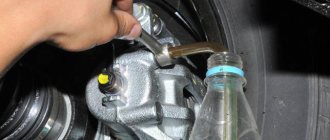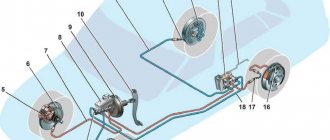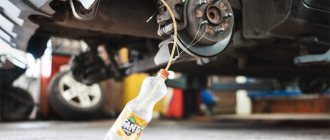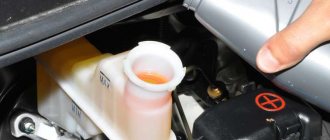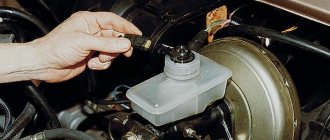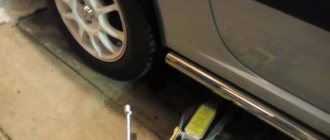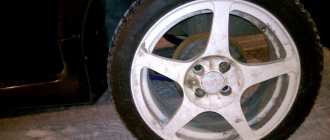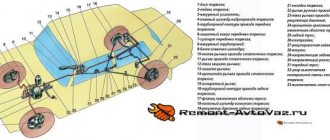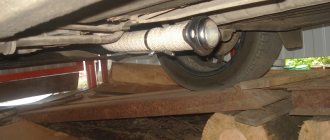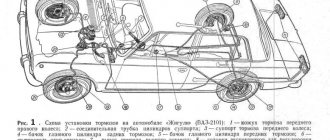Maintaining the required level of brake fluid is necessary for the proper operation of the vehicle's braking system. How much is needed can always be found in the service book, but often car owners are not used to looking into it, but act empirically or look for the answer on the Internet. It is these users that we will try to help figure out the question of how much brake fluid is needed for replacement and which one should be poured.
Brake fluid is the working fluid of the brake system, with its help the force created in the master cylinder is transmitted to the wheel pairs.
If the brake fluid level is below the minimum mark (by the way, this will be indicated by the corresponding icon on the instrument panel - a red circle with waves inside), then you need to top it up. It also doesn’t hurt to check the master brake cylinder and the brake system as a whole, since a decrease in the fluid level may indicate a malfunction or wear of the master cylinder gaskets. As a rule, the brake system of a passenger car contains from 0.55 to 1.0 liters of brake fluid. And its specification can very often be indicated on the body of the expansion tank or its cap.
When checking, do not forget to pay attention to the color of the liquid . The new TJ is transparent with a yellowish tint. During operation, it changes its color and becomes dark, this is mainly due to the accumulation of various impurities. If the fluid has darkened, this may mean that a complete replacement is necessary and simple topping up is not enough.
Experts recommend replacing brake fluid approximately every 2-3 years ; this interval is optimal, because the shelf life of the fluid can vary depending on hygroscopicity and susceptibility to temperature loads. For the brake mechanisms to function properly, the fluid must have a number of properties and also meet a certain standard.
WHEN TO CHANGE
The main reason for changing brake fluid is moisture getting into the system. This leads to unpleasant consequences. For example, it can simply freeze in winter (this cannot happen with a clean one), and this can cause not only brake failure, but also damage to pipes and other elements of the car. And replacing brake hoses on a VAZ2114 is not a pleasant matter. However, this process is quite long, and takes about 2-3 years, in the absence of breakdowns in the system, after which it is necessary to replace the brake fluid of the VAZ 2114.
In summer this problem is also relevant. Moisture, as you know, tends to boil. So, prolonged braking can lead to exactly this, as a result of which the car simply stops braking.
Mileage and intensity of brake use also affects fluid performance. For the VAZ 2114, it is recommended to change the fluid in the entire system after 30,000 kilometers. Detailed operating rules are listed in the vehicle documentation.
Problems with the backlight of the VAZ-2110 dashboard: causes and repairs
It’s probably no secret to anyone that the reliability of VAZ “ten” leaves much to be desired. Often, the owners of these cars have to deal with certain malfunctions. One of these problems is the lack of dashboard lighting. It is clear that the breakdown should be corrected as soon as possible. After all, going somewhere at night will be quite problematic - few people will like to move, essentially, blindly, without seeing either the current speed or other, no less important indicators.
SIGNS OF PROBLEM
When the fluids are partially used up, the brake system begins to work incorrectly. The pedal begins to sink or becomes soft. Braking occurs silently, and the braking trail gradually increases. The car may skid when the brakes are pressed.
Having discovered one of the signs, the first thing you should do is look into the brake fluid reservoir. A cloudy color and the presence of sediment are an alarming signal; it’s time to go shopping, because you urgently need to change the brake fluid on your VAZ 2114.
Change brake fluid immediately - if necessary
Types and properties of fuel fluid
Old and new brake fluid
Any brake fluid has 93-98% of the main composition and from 2 to 7% of additives, which, in fact, are the key component for imparting the declared characteristics.
In general, if you look at it this way, the properties of brake fluid depend on the combination of its components. Depending on the composition of the base, TJ is divided into 3 groups.
Types of brake fluids:
- Mineral (mineral oil LHM) . They consist of alcohol and castor oil.
- Glycolic . Developed on the basis of polyglycols and their esters.
- Silicone . Manufactured from silicon-organic polymer products.
Regardless of the type and composition, all brake fluids are divided into two classifications.
Classification of TJ:
- By viscosity.
- By boiling point:
- for “dry” liquid (without water);
- “wet”, which contains 3.5% water.
If the boiling point exceeds the permissible norm, then there is a risk of a vapor lock forming in the system (as a result of moisture evaporation), which can lead to breakdown and failure of the brake pedal.
REPLACEMENT PROCESS
Before starting work, you need to stock up on the following tools:
- Hose 10-15 centimeters long and 6 mm in diameter;
- Wrenches for 8 and 10;
- Plastic bottle;
- Gloves (work clothes and safety glasses are also a good idea);
- Hydraulic fluid (there are a lot of manufacturers, each with its own characteristics).
Having collected all the tools, you can start working. The procedure is not complicated and does not require any professional skills. Most motorists do the replacement themselves.
It is extremely difficult to do this kind of work alone, so I recommend taking a friend with you who will undoubtedly help in the process. This will not only save time, but will also greatly simplify the procedure.
We are changing bunker - 4 in the VAZ 2114 in stages:
- We park the car on a pit or overpass;
- Remove the cap from the brake reservoir;
- We go into the pit. Here we need a fitting located on the rear right wheel;
- It is closed with a cap, which we remove;
- Take a bottle and pour some DOT-4 into it;
- We put the hose on the fitting and lower the other end into the bottle (do not forget to lower it to the bottom);
- Now you need someone to press the brake pedal. Smoothly 7-8 times in a row, and the last press all the way and hold;
- Unscrew the fitting a couple of turns;
- We observe how the waste product comes out;
- When 1-1.5 centimeters remain in the tank (it is important not to be late, otherwise air will enter the system), tighten the fitting and release the pedal;
- Add the missing DOT-4 to the tank (up to the Maximum mark);
- Then we repeat the procedures with the fitting and pressing the pedal until clean pillbox flows into the bottle;
- We tighten the fitting and move on to the next wheel.
There is a specific order in which the replacement must be performed. After the left rear wheel, we need the right front, then the left rear and finally the right front. If you started doing everything according to the instructions, then this is the sequence in which the bunker runs.
Leave a comment Cancel reply
html, https://vaz-russia. ru/remont-vaz-2113/prokachka-tormozov-na-vaz-2113-vaz-2114-vaz-2115. html.
I decided not to spend money on this procedure and stir up something like that so as not to return to this issue. And so, in order... We take the plug of the expansion tank of the brake system, drill a 16 mm hole, this is exactly the inner diameter of the upper skirt where the fuel fluid level sensor was located, while it (the plug) retains the greatest strength. It looks something like this:
Next, we find a fitting of a suitable diameter (let me remind you, it is 16 mm) and try to push it in. It should fit very tightly and have an outlet of such a diameter that you can put a hose on it with the diameter of a regular pump (or compressor). I found this one in the garage:
I sharpened it in the place intended for turning with a key, to the recommended 16 mm. It turned out like this:
Then he inserted it into the intended place in the traffic jam, it stood very tightly, which is what was required to be achieved.
Because tight fixation is not enough, I decided to pour epoxy glue inside the cork, which was done. The glue was poured into the place indicated between the two red circles in the figure below:
There are grooves in the plug to prevent vacuum and excess pressure in the expansion tank, so they also need to be carefully filled with epoxy glue, an ordinary toothpick will help with this, and of course glue.
The rubber seal, which is normally placed in the plug, must be left, carefully cutting off the “skirt” to prevent the passage of air during pumping. To be honest, I missed this, so I used regular foam, which I wrapped around the neck of the expansion tank. In principle, the nano-plug is ready.
Next, everything is even simpler, we take a hose for the pump 1.5-2 m long (as convenient for you) and a tip, which we usually put on the nipple when inflating the wheel. I recommend taking the one that is at 90 degrees, because... a straight line will allow air to pass through when the hose is bent. We fasten everything with clamps and the device is ready. We also need a thin hose to put it on the bleeder fitting, a transparent bottle, and a 10 or 8 wrench.
The whole thing looks like this:
To replace the fuel tank and flush the brake system, I needed 1.5 liters. brake fluid DOT4 and 15 minutes of time. The result is obvious, in the can of brake fluid that was there, and in the bottle that is now (drained at the time of pumping the last circuit).
None Good luck on the roads, Friends!
- remont2114.club
- vaz-2114-lada.ru
- ladafakt.ru
- www.drive2.ru
WHICH LIQUID TO CHOOSE
The technical documentation describes in detail recommendations on what brake fluid to fill in the VAZ 2114. However, many motorists choose the product individually for themselves. Some prefer Bosh bunkers, others Ferodo or TRW. There are many brands of manufacturers with different technical properties to choose from. If the recommended product does not suit you in any way, you can contact a service station for help. There they will describe to you in detail the pros and cons of all famous brands. In our case, DOT-4 synthetic is recommended. This is an excellent brake fluid for VAZ 2114.
When choosing, you can pay attention to the technical properties of the product. The best samples should have high scores in the following parameters:
- Boiling temperature;
- Viscosity;
- Anti-corrosion.
DOT 4 Ferodo
The higher these parameters, the better. Choose wisely.
Recommendations for servicing the brake circuit of the VAZ 2114
- Conduct scheduled technical inspections of the vehicle in a timely manner;
- When purchasing, carefully check the catalog numbers with the data specified in the instruction manual;
- Use the services of certified points of sale.
Service station experts recommend purchasing DOT-4 on semi-synthetic and synthetic bases. It is “synthetics” that meets many modern requirements and quality standards.
Mineral-based lubricants are not always effective for high speed conditions and systematic loads. If you have any difficulties choosing a technical vehicle for a VAZ 2114, contact service station specialists and auto store managers for help.
HOW MUCH TO BUY
The VAZ 2114 system has a volume of 750 milliliters. Taking into account pumping and unforeseen situations, one liter is enough. There will be some left over for topping up. There is no need to carry it with you and constantly top up the pillbox. You can buy it in any quantity at any gas station. Motorists who have been driving for several years can always find out how much brake fluid is in the VAZ2114 system.
It must be remembered that DOT-4 is extremely toxic, so spilling it on open skin is highly undesirable. Therefore, it is not worth storing it in the trunk.
Design
The task of the driver and car owner part-time is to constantly monitor the condition of the brake system.
Failure of one of its elements can lead to serious consequences. Therefore, you should know what exactly is included in the braking system.
- Brake fluid reservoir mounted on the GTZ;
- Metal pipelines of two circuits;
- Flexible brake hoses for front and rear wheels;
- GTZ ( brake cylinder located in the engine compartment);
- Brake cylinders of front and rear wheels;
- Pressure regulator;
- Brake fluid level sensor;
- Vacuum booster.
Tank with TJ
According to the recommendations of specialists, the replacement of the TZ is carried out once every 3 years, but at least once every 45 thousand kilometers.
REPLACEMENT
Some drivers don’t even know where to fill the brake fluid in the VAZ 2114 (even though the VAZ brake fluid reservoir is visible), not to mention the rules. DOT-4 needs to be added only if its level in the tank has dropped below the halfway point between the MIN and MAX marks. To do this, simply unscrew the tank cap and fill it to the top mark. The brake fluid volume should not exceed the maximum mark.
Do not under any circumstances mix products from different manufacturers and brands. This may lead to system failure, which will adversely affect your financial situation when contacting the service. Be sure to ask an expert how to add brake fluid.
In general, if all necessary conditions and rules are observed, everything is done quite simply. Any measures to normalize the operation of a car require certain tools and special clothing. This should not be forgotten, since contact with human skin of chemicals contained in fuels and lubricants is extremely dangerous to health.
But whatever one may say, in the quest for durability and reliability of your car there is nothing you can do. The acquired skills can be applied not only to the VAZ 2114, but also to other models of the domestic automobile industry. For example, the VAZ 2115 has an absolutely identical device.

